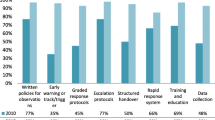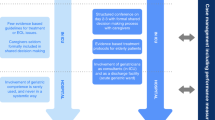Abstract
Background and objectives
An important component of efficient and high-quality treatment of patients under DRG conditions is the control of patients’ length of stay in hospitals. Medical processes need to be structured in such a way that unnecessary extensions of the length of stay are avoided, thus achieving an economically and qualitatively optimal result. The study presented here examines the question of whether the introduction of length-of-stay-oriented case management can optimize the duration of patients' hospital stays.
Methods
In total, 168 inpatient cases and their matched control cases from the cardiology and urology stations of a maximum care hospital are examined in this study.
Results
The result of the t-test for the difference of means indicates that the average length of stay of the intervention cases (5.79 days) was significantly shorter than the average length of stay of the control cases (7.34 days). With respect to the re-admission rate, a statistically significant dependence could not be determined.
Discussion and conclusion
The operationalization of case management in daily clinical routines was tested by a comprehensive survey. Length-of-stay-oriented case management provides transparency of the entire treatment process and integrates procedures to an optimal extent. However, the doctor's sovereignty over therapy is not affected by the introduction of length-of-stay-oriented case management. Hence, the form of case management presented here serves as a new and innovative control and monitoring system for hospitals, as it makes institutions that implement such a system more competitive through the improvement of economical aspects as well as through the introduction of higher process efficiency.


Similar content being viewed by others
References
Bennett PJ, Fosbinder D, Williams M (1997) Care coordination in an academic medical center. Nurs Case Manag 2(2):75–82
Berenholtz SM, Dorman T, Ngo K, Pronovost PJ (2002) Qualitative review of intensive care unit quality indicators. J Crit Care 17(1):1–12
Cudney AE (2002) Case management: a serious solution for serious issues. J Healthc Manag 47(3):149–152
Daniels S (1999) Using hospital-based case management to reduce payer denials. Healthc Financ Manage 53(5):37–39
Ethridge P (1991) A nursing HMO: Carondelet St. Mary`s experience. Nurs Manag 22(7):22–27
Ewers M, Schaeffer D (2000) Case management in Theorie und Praxis. Huber, Bern
Fahrmeir L, Künstler R, Pigeot I et al (2001) Statistik—Der Weg zur Datenanalyse, 3rd edn. Springer, Berlin
Gertmann PM, Restuccia JD (1981) The appropriateness evaluation protocol: a technique for assessing unnecessary days of hospital care. Med Care 19(8):855–871
Juni P, Altman D, Egger M (2001) Systematic reviews in health care: assessing the quality of controlled clinical trials. BMJ 323(7303):42–46
Kim YJ, Soeken KL (2005) A meta-analysis of the effect of hospital-based case management on hospital length-of-stay and readmission. Nurs Res 54(4):255–264
Krusch A, Siegmund T, Huber P, Kircher M, Schumm-Draeger PM (2006) Clinical Pathways und case-Management als DRG-Managementinstrumente. Das Krankenhaus 124-128
Kuntz L, Scholtes S, Vera A (2007) Incorporating efficiency in hospital-capacity planning in Germany. Eur J Health Eco 8(3):213–223
Lehmann U, Köpfer T (2002) DRGs als Rahmen für strukturelle Neuerungen im Krankenhaus–Beispiel: case-manager im Unfallkrankenhaus Berlin. Electromedica 70(2):116–118
Löcherbach P (2003) Einsatz der methode case management in Deutschland: Übersicht zur Praxis im Sozial- und Gesundheitswesen. In: Porz F, Erhardt H (eds) Neue Wege in der Nachsorge und Palliativversorgung. BetaInstitutsverlag, Augsburg, pp 20–33
OECD (Organisation for Economic Co-operation and Development) (2006) OECD Health Data 2006. Paris
Olivas GS, Del Togno-Armanasco V, Erickson JR et al (1989a) Case management: a bottom-line care delivery model, Part I. J Nurs Adm 19(11):16–20
Olivas GS, Del Togno-Armanasco V, Erickson JR et al (1989b) Case Management: A bottom-line care delivery model, Part II. J Nurs Adm 19(12):12–17
Powell SK, Ignatavicius D (2001) Core curriculum for case management. Lippincott, Philadelphia
Roddy SP, O'Donell TF, Iafrati MD, Isaacson LA, Bailey VE, Mackey WC (1998) Reduction of hospital resources utilization in vascular surgery: a 4-year experience. J Vasc Surg 27(6):1066–1075
Roggenkamp SD, White KR, Bazzoli GJ (2005) Adoption of hospital case management: economic and institutional influences. Soc Sci Med 60:2489–2500
Shi L (1996) Patient and hospital characteristics associated with average length of stay. Health Care Manag Rev 21(2):46–61
Southern WN, Berger MA, Bellin EY et al (2007) Hospitalist care and length of stay in patients requiring complex discharge planning and close clinical monitoring. Arch Intern Med 167(17):1869–1874
Suh DC, Woodall BS, Shin SK et al (2000) Clinical and economic impact of adverse drug reactions in hospitalized patients. Ann Pharmacother 34(12):1373–1379
Tahan HA (1998) Case management: a heritage more than a century old. Nurs Case Manag 3:55–60
Terra SM (2007) An evidence-based approach to case management model selection for an acute care facility: is there really a preferred model? Prof Case Manag 12(3):147–57
Walters J, Schwartz CF, Monaghan H, Watts J, Shlafer GJ, Deeb GM, Bolling SF (1998) Long-term outcome following case management after coronary artery bypass surgery. J Card Surg 13(2):123–128
Wendt WR (2002) Case management–stand und Positionen in der Bundesrepublik. In: Löcherbach P, Klug W, Remmel-Faßbender R, Wendt WR (eds) Case management - fall- und systemsteuerung in Theorie und Praxis. Luchterhand, Neuwied, pp 13–36
Wissert M (2006) Clinical pathways–entlassungsmanagement–unterstützungsmanagement, begriffserklärung und Systematisierung ausgewählter case management-strategien. Case Manag 2(1):35–38
Woods JR, Saywell RM, Nyhuis AW, Jay SJ, Lohrman LG, Halbrook HG (1992) The learning curve and the cost of heart transplantation. Health Serv Res 27:219–238
Yamamoto L, Lucey C (2005) Case management "within the walls": a glimpse into the future. Crit Care Nurs Q 28(2):162–178
Zander K (2002) Nursing case management in the 21st century: intervening where margin meets mission. Nurs Administration Q 26(5):58–67
Acknowledgements
We would like to express our gratitude to the staff of the hospital departments where this study was conducted, as well as to the patient administration at the Dr. Horst Schmidt Clinic of the City of Wiesbaden. In particular, we would like to thank the accompanying clinic directors, Dr. Klaus Kleinschmidt and Dr. Martin Sigmund for their strong support. We would also like to thank Dr. Reiner Leidl (Helmholtz Center Munich) for his advice on earlier versions of this paper.
Conflict of interest disclosure
The authors disclose any relevant associations that might pose a conflict of interest.
Author information
Authors and Affiliations
Corresponding author
Rights and permissions
About this article
Cite this article
Kainzinger, F., Raible, C.A., Pietrek, K. et al. Optimization of hospital stay through length-of-stay-oriented case management: an empirical study. J Public Health 17, 395–400 (2009). https://doi.org/10.1007/s10389-009-0266-5
Received:
Accepted:
Published:
Issue Date:
DOI: https://doi.org/10.1007/s10389-009-0266-5




